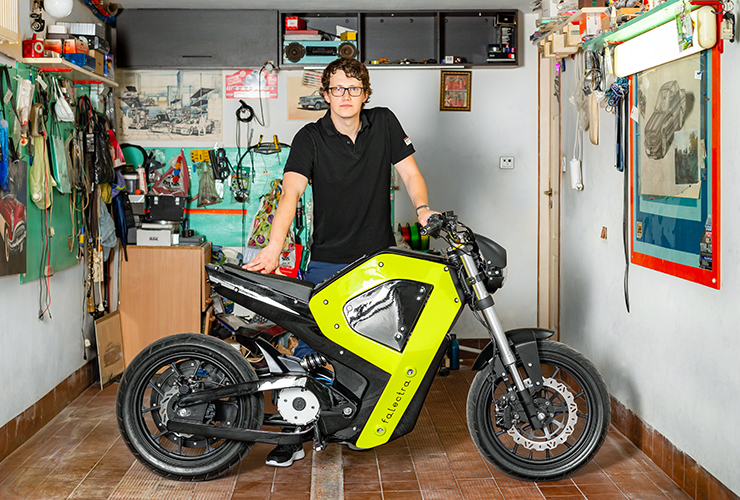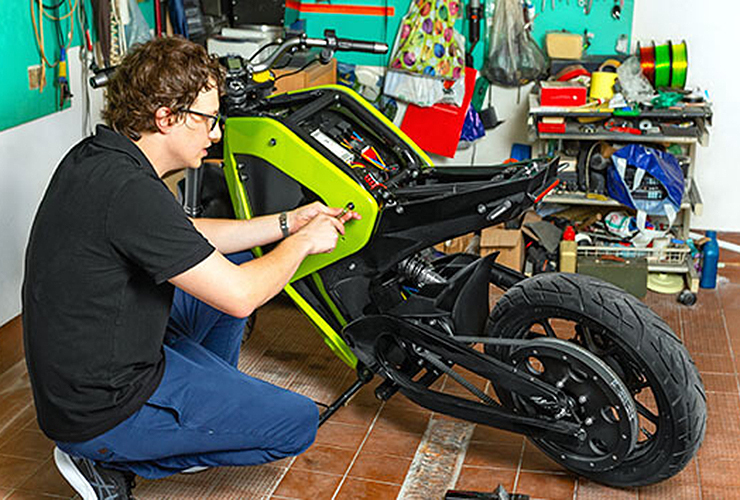Source: press release Zortrax | Young designer Piotr Krzyczkowski has created a comfortable, economical and green transport solution for city dwellers. Modern technology, including 3D printing, played a pivotal role in bringing his idea to life – creating a motorbike prototype, convincing investors and obtaining funding for the project. The result is Falectra, the first Polish electric motorbike brand. Its first motorbikes will appear on the country’s roads next year.

The designer got the idea during a trip to Milan. Two-wheelers of all kinds have been popular on Italy’s narrow streets for decades. Now cities worldwide are seeking similar, alternative transport solutions that will reduce traffic congestion and be better for the environment, zero-emission and quiet. The Polish motorbikes fulfil all these criteria. They are also very affordable, covering 100 km (62 mi) for less than 0,25 USD.
The motorbike was developed in two stages. The first involved developing the final version and patenting it. The necessary opinions and funding had to be obtained, too. This took almost two years. The second stage involved creating a fully functioning prototype. Having a “physical” model of a project is very important for start-ups in the e-mobility sector; it helps them show investors its value and ground futuristic projects in reality.

“Alone, a ‘virtual project’ is no longer enough for partners and investors. We had to show a fully functioning prototype. Yet simply creating the laminate panels that form the vehicle’s bodywork would have cost PLN 150,000-200,000 (39,000 – 52,000 USD) – way beyond our budget. That’s when we started thinking about 3D printing. Through our cooperation with Zortrax, the parts needed to assemble the prototype were created on their printers. The whole process cost almost seven times less and we were able to show the world a functioning motorcycle,” says Piotr Krzyczkowski, Falectra’s owner.

Designing a vehicle using a computer program is relatively simple, which has led to a wave of new designers and visionaries offering innovative solutions. However, most of them only work “on paper”. With a prototype, companies can better evaluate mass production, which is key when planning a budget and determining a product’s price for the end user. In Falectra’s case, creating a fully functioning prototype took just half a year. This was made possible by Zortrax, which printed the necessary parts on its 3D printers.
“We knew that the print’s durability was the priority, so that the motorbike created by Piotr would be fully functioning and ready to use. We chose the Z-ULTRAT material, which can endure heavy loads, and used the M200 Plus and M300 Plus printers. This enabled us to create parts that fully reflect the appearance and functionality of these motorbikes, which will soon be mass-produced,” adds Miłosz Bertman, Lead 3D Designer at Zortrax.
Using modern parts and technology resulted in a light construction and a prototype that can be improved on an ongoing basis. Locating the battery as low as possible results in a stable motorbike that is easy to ride. A practical storage box is mounted where the tank would have been. The vehicle can travel up to 70 km on a single charge and reach a speed of up to 60 km (32 mi)/h.

The first 10 motorbikes will be allowed on the road for research purposes next year. Mass production will begin in 2021. The motorbike will cost around PLN 15,000 (4000 USD) for individual customers.
About Zortrax
Zortrax is a developer of comprehensive 3D printing solutions offering dedicated filaments, Z-SUITE software and additional devices to improve the printing process and post processing. Zortrax products are used by thousands of customers around the world in a wide range of industries, such as architecture, medicine, automotive, engineering, industrial prototyping and fashion. Zortrax products have garnered multiple awards in the 3D printing industry. The company is based in Poland.